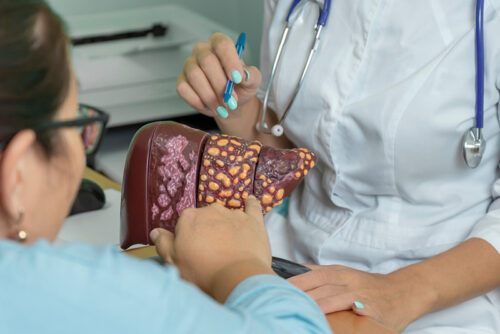Though the skin wins the title of largest human organ, the title of heaviest organ, and largest internal organ, goes to the liver. Weighing an average of 3lbs or 1.36kg in a healthy adult and roughly the size of a football, the liver performs many critical metabolic and detoxification functions.
Anatomy and functions of the liver
The liver is a large organ located in the upper right side of the abdomen. It has four lobes and is supplied with blood from two different places: the portal vein, which carries blood rich in nutrients from the gastrointestinal system, and the hepatic artery, which brings oxygen-rich blood to the liver. The liver has a unique dual circulation system, allowing it to perform its plethora of functions.
The liver is responsible for several vital functions, including the production of bile, which is necessary for the digestion of fats. It also plays a role in the metabolism of carbohydrates, converting glucose into glycogen for storage and releasing it as needed to maintain blood glucose levels.
Additionally, the liver helps to detoxify harmful substances, including drugs, alcohol, and other toxins, by converting them into less harmful compounds or excreting them from the body.
Bilirubin metabolism
Bilirubin is a yellow pigment that is created during the breakdown of red blood cells. It is transported to the liver, where it is conjugated with glucuronic acid to form water-soluble bilirubin.
This conjugated bilirubin is then excreted into the bile and ultimately eliminated from the body in the feces. If the conjugated bilirubin is not able to be excreted, hyperbilirubinemia, also known as jaundice, may occur. If something occurs in the body that results in too much bilirubin, prevents uptake, or prevents the bilirubin from being conjugated, then the unconjugated bilirubin, which is not water-soluble, can accumulate in the blood leading to jaundice. Unconjugated hyperbilirubinemia is commonly seen in infants.
Liver function tests
Laboratory studies are used to evaluate liver function. These tests include liver enzyme levels, such as alanine aminotransferase (ALT), aspartate aminotransferase (AST), and alkaline phosphatase (ALP), as well as bilirubin levels.
Abnormal levels of these markers may indicate liver dysfunction or damage.
Drug metabolism
The liver is responsible for the metabolism of many drugs. The liver converts these into inactive compounds, which are later excreted from the body. First-pass metabolism refers to the initial metabolism of a drug by the liver, which can result in the conversion of the drug to an active or inactive form leading to a lower concentration of active drug available at the sight of action.
The liver uses two sets of chemical reactions, known as phase I and phase II reactions, to metabolize drugs. Phase I reactions involve the oxidation, reduction, or hydrolysis of the drug, while phase II reactions involve the conjugation of the drug with another molecule, such as glucuronic acid or sulfate. Phase I reactions are mediated by cytochrome P450 enzymes.
Causes of acute liver failure
Acute liver failure is a rare but life-threatening condition that occurs when the liver suddenly loses its ability to function. The major derivations of acute liver failure include viral hepatitis, drug-induced liver injury, and autoimmune hepatitis.
Other causes include Wilson’s disease, Budd-Chiari syndrome, HELLP syndrome, and hemochromatosis.
Drug-induced liver injury
Researchers associate several drugs with liver toxicity, including acetaminophen, NSAIDs, antiepileptic drugs, and antibiotics. Acetaminophen is the leading cause of drug-induced liver injury in the United States and can cause acute liver failure at high doses.
Acetaminophen undergoes first-pass metabolism in the liver, resulting in the production of a toxic metabolite that can cause liver damage if it overwhelms the detoxification process. N-acetylcysteine (NAC) is an antidote that can treat an acetaminophen overdose by replenishing the glutathione levels in the liver, which help to neutralize the toxic metabolite.
Stages of acetaminophen toxicity
Acetaminophen toxicity occurs in four stages. The first stage occurs within 24 hours of ingestion. Patients in this stage experience nausea, vomiting, and abdominal pain. The second stage occurs between 24 and 48 hours and is marked by a transient amelioration of symptoms.
The third stage occurs between 48 and 72 hours. Elevated liver enzymes and jaundice signal the onset of liver injury. The fourth stage occurs 3 to 5 days after ingestion with the beginnings of liver failure.
Hepatitis A, B, and C
Hepatitis A, B, and C are viral infections that can unfortunately pave the way to acute and chronic liver disease. While blood and bodily fluids can spread hepatitis B and C, hepatitis A typically spread through contaminated food or water. Chronic infection brought on by hepatitis B and C can result in cirrhosis and liver cancer.
Therapy for viral hepatitis includes antiviral medications, supportive care, and vaccination to prevent infection.
Stages of liver disease
Liver disease is classified into several stages, including fatty liver disease, hepatitis, cirrhosis, and liver failure. Fatty liver disease occurs when fat accumulates in the liver, while hepatitis refers to inflammation of the liver. Cirrhosis is a late-stage liver disease involving irreversible liver scarring, which can lead to liver failure and loss of liver function.
Maddrey’s discriminant function and MELD scores
Clinicians use the model for end-stage liver disease (MELD) score and Maddrey’s discriminant function to predict the prognosis of individuals with liver failure. The MELD score is used to rank patients for liver transplantation according to the severity of the liver disease and risk of mortality. Maddrey’s discriminant function uses laboratory results to predict poor prognosis and indication for steroid use in individuals with alcoholic hepatitis.
Wilson’s disease, Budd-Chiari syndrome, and hemochromatosis
Budd-Chiari syndrome, Wilson’s disease, and hemochromatosis are rare genetic disorders that affect the liver. Wilson’s disease is a disorder of copper metabolism which can cause liver disease. Budd-Chiari syndrome is a rare condition involving a blockage in the hepatic veins, which leads to liver damage.
Hemochromatosis is a condition where the body absorbs too much iron from the diet. This leads to an iron overload in the liver and other organs, which can eventually cause liver damage.
Related course: Earn CE hours by watching Acute Liver Failure: Etiology, manifestations, and clinical management (free with Passport Membership)!






